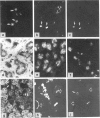Abstract
Immunoglobulin-producing cells and epithelial expression of secretory component (SC), amylase, lysozyme (Ly) and lactoferrin (Lf) were studied by immunohistochemistry to obtain information about the development of mucosal immunity. Tissue specimens were obtained from 20 fetal and 40 postnatal parotid glands. (1) Fetal specimens. Occasional IgM- and IgA- but no IgD-, IgG- or IgE- producing cells were seen (ratios, IgM:IgA:IgD:IgG:IgE approximately 4:1:0:0:0). The IgAl subclass dominated (median 90%, range 50-95%) and these cells were mostly J-chain-positive (median 97%, range 94-98%). Only few IgA2-producing cells were seen (median 10%, range 5-50%) and they were also mostly J-chain-positive (median 99%, range 98-100%). Amylase, Ly and Lf were most prominent in early fetal life, while only small amounts of SC were present. (2) Postnatal specimens. Secretory component increased markedly along with a growing number of IgA- and IgD-producing cells (IgA:IgM:IgD:IgG:IgE approximately 4:2:1:1:0). The IgAl subclass remained predominant (median 65%, range 50-90%) although the proportion of IgA2-positive cells tended to be raised (median 35%, range 10-50%). Most IgAl (median 97%, range 67-100%) and IgA2 (median 94%, range 75-100%) cells were J-chain-positive. These features probably reflected local activation of the immune system in response to environmental factors. The amount of amylase, Ly and Lf decreased shortly after delivery, perhaps because the cellular stores were emptied by postnatal increase in secretory activity.
Full text
PDF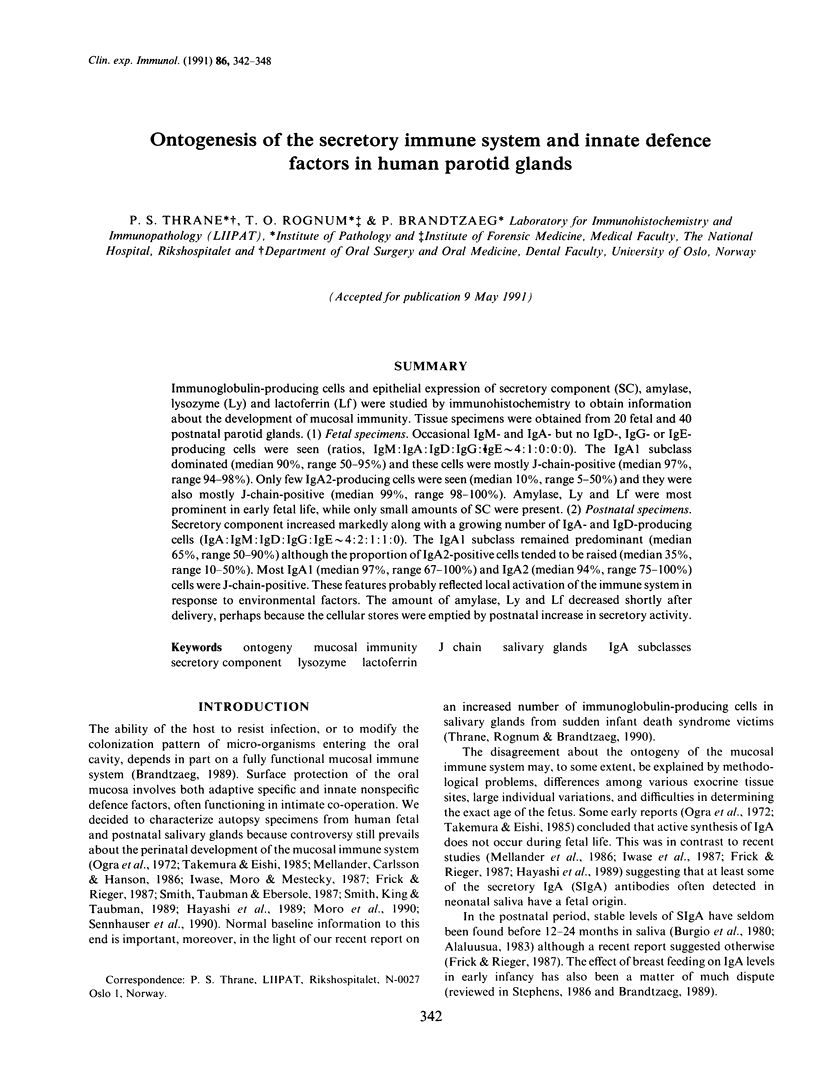


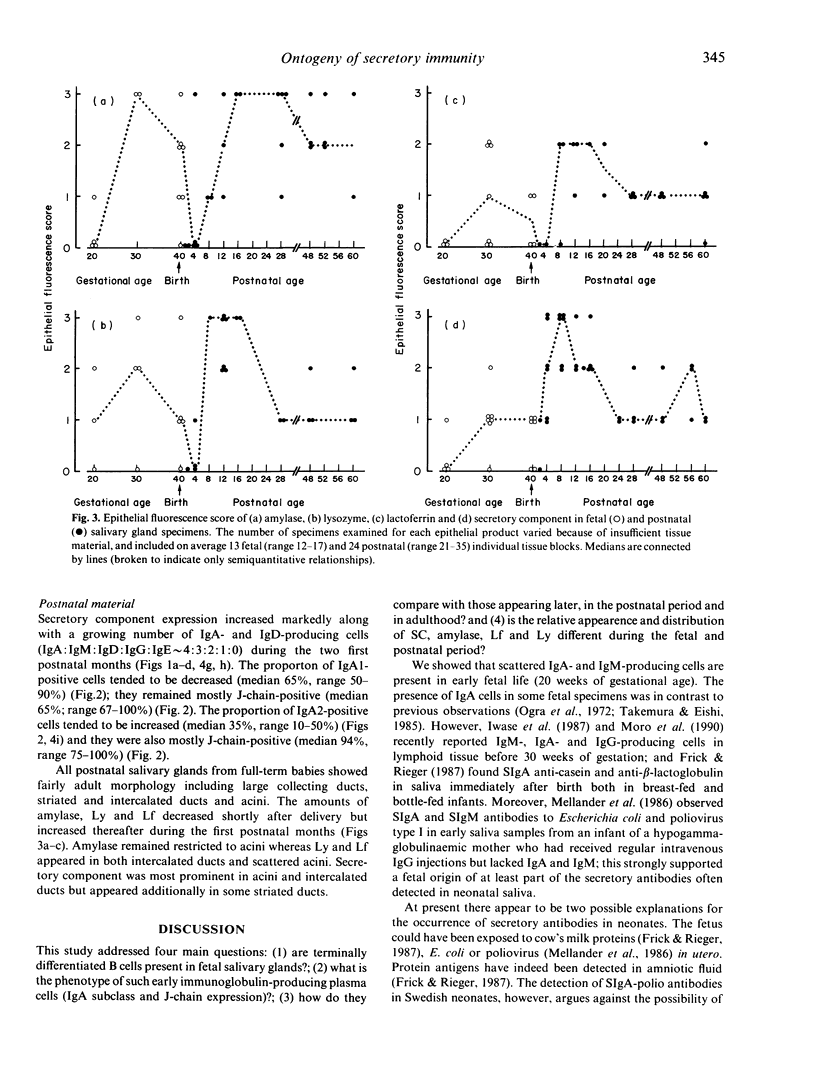
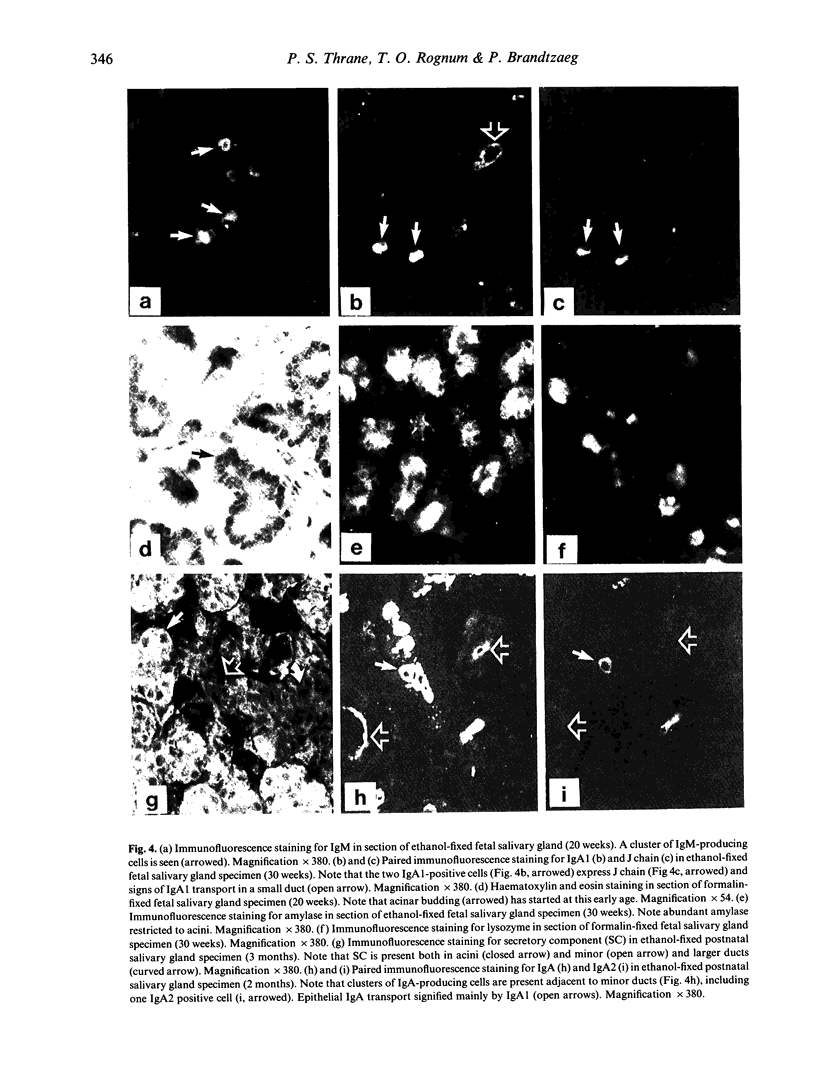

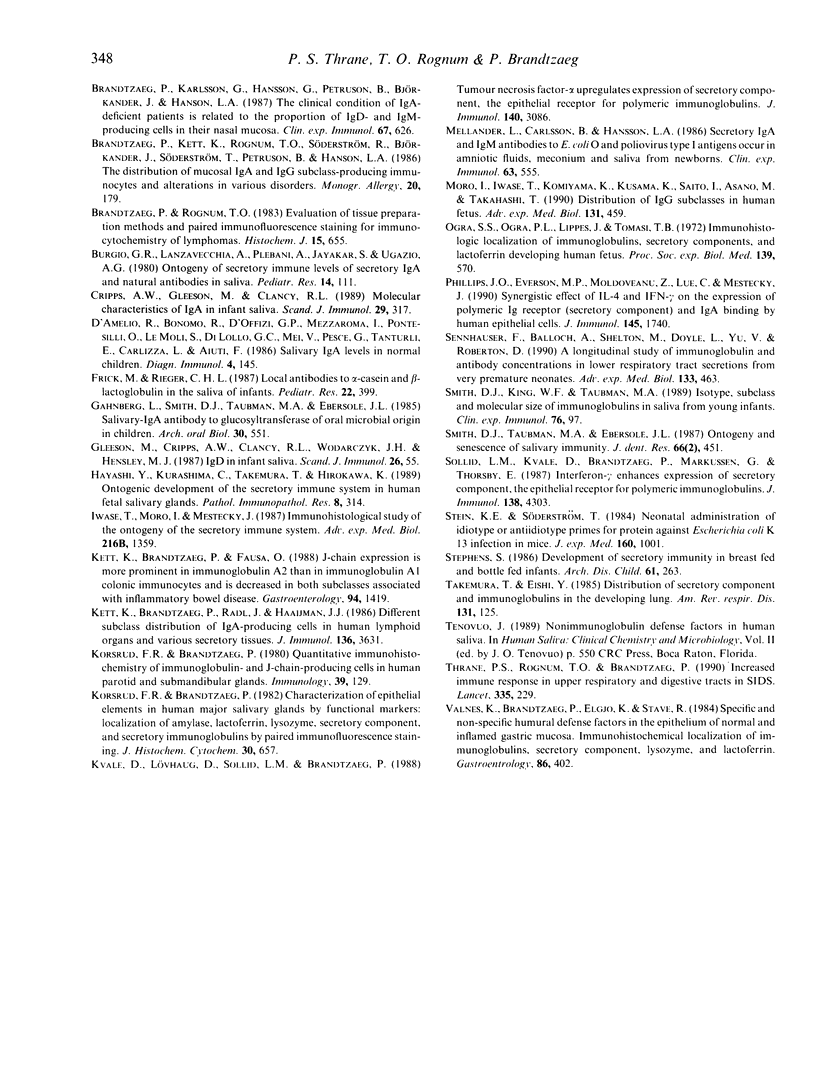
Images in this article
Selected References
These references are in PubMed. This may not be the complete list of references from this article.
- Alaluusua S. Longitudinal study of salivary IgA in children from 1 to 4 years old with reference to dental caries. Scand J Dent Res. 1983 Jun;91(3):163–168. doi: 10.1111/j.1600-0722.1983.tb00796.x. [DOI] [PubMed] [Google Scholar]
- Bortner C. A., Miller R. D., Arnold R. R. Effects of alpha-amylase on in vitro growth of Legionella pneumophila. Infect Immun. 1983 Jul;41(1):44–49. doi: 10.1128/iai.41.1.44-49.1983. [DOI] [PMC free article] [PubMed] [Google Scholar]
- Brandtzaeg P., Gjeruldsen S. T., Korsrud F., Baklien K., Berdal P., Ek J. The human secretory immune system shows striking heterogeneity with regard to involvement of J chain-positive IgD immunocytes. J Immunol. 1979 Feb;122(2):503–510. [PubMed] [Google Scholar]
- Brandtzaeg P. Human secretory immunoglobulins. VII. Concentrations of parotid IgA and other secretory proteins in relation to the rate of flow and duration of secretory stimulus. Arch Oral Biol. 1971 Nov;16(11):1295–1310. doi: 10.1016/0003-9969(71)90033-1. [DOI] [PubMed] [Google Scholar]
- Brandtzaeg P. Immunohistochemical characterization of intracellular J-chain and binding site for secretory component (SC) in human immunoglobulin (Ig)-producing cells. Mol Immunol. 1983 Sep;20(9):941–966. doi: 10.1016/0161-5890(83)90036-6. [DOI] [PubMed] [Google Scholar]
- Brandtzaeg P., Karlsson G., Hansson G., Petruson B., Björkander J., Hanson L. A. The clinical condition of IgA-deficient patients is related to the proportion of IgD- and IgM-producing cells in their nasal mucosa. Clin Exp Immunol. 1987 Mar;67(3):626–636. [PMC free article] [PubMed] [Google Scholar]
- Brandtzaeg P., Kett K., Rognum T. O., Söderström R., Björkander J., Söderström T., Petrusson B., Hanson L. A. Distribution of mucosal IgA and IgG subclass-producing immunocytes and alterations in various disorders. Monogr Allergy. 1986;20:179–194. [PubMed] [Google Scholar]
- Brandtzaeg P. Mucosal and glandular distribution of immunoglobulin components. Immunohistochemistry with a cold ethanol-fixation technique. Immunology. 1974 Jun;26(6):1101–1114. [PMC free article] [PubMed] [Google Scholar]
- Brandtzaeg P. Prolonged incubation time in immunohistochemistry: effects on fluorescence staining of immunoglobulins and epithelial components in ethanol- and formaldehyde-fixed paraffin-embedded tissues. J Histochem Cytochem. 1981 Nov;29(11):1302–1315. doi: 10.1177/29.11.7033362. [DOI] [PubMed] [Google Scholar]
- Brandtzaeg P., Rognum T. O. Evaluation of tissue preparation methods and paired immunofluorescence staining for immunocytochemistry of lymphomas. Histochem J. 1983 Jul;15(7):655–689. doi: 10.1007/BF01002987. [DOI] [PubMed] [Google Scholar]
- Cripps A. W., Gleeson M., Clancy R. L. Molecular characteristics of IgA in infant saliva. Scand J Immunol. 1989 Mar;29(3):317–324. doi: 10.1111/j.1365-3083.1989.tb01130.x. [DOI] [PubMed] [Google Scholar]
- D'Amelio R., Bonomo R., D'Offizi G. P., Mezzaroma I., Pontesilli O., Le Moli S., Di Lollo G. C., Mei V., Pesce G., Tanturli E. Salivary IgA levels in normal children. Diagn Immunol. 1986;4(3):145–148. [PubMed] [Google Scholar]
- Frick M., Rieger C. H. Local antibodies to alpha-casein and beta-lactoglobulin in the saliva of infants. Pediatr Res. 1987 Oct;22(4):399–401. doi: 10.1203/00006450-198710000-00006. [DOI] [PubMed] [Google Scholar]
- Gahnberg L., Smith D. J., Taubman M. A., Ebersole J. L. Salivary-IgA antibody to glucosyltransferase of oral microbial origin in children. Arch Oral Biol. 1985;30(7):551–556. doi: 10.1016/0003-9969(85)90056-1. [DOI] [PubMed] [Google Scholar]
- Gleeson M., Cripps A. W., Clancy R. L., Wlodarczyk J. H., Hensley M. J. IgD in infant saliva. Scand J Immunol. 1987 Jul;26(1):55–57. doi: 10.1111/j.1365-3083.1987.tb02234.x. [DOI] [PubMed] [Google Scholar]
- Hayashi Y., Kurashima C., Takemura T., Hirokawa K. Ontogenic development of the secretory immune system in human fetal salivary glands. Pathol Immunopathol Res. 1989;8(5-6):314–320. doi: 10.1159/000157159. [DOI] [PubMed] [Google Scholar]
- Iwase T., Moro I., Mestecky J. Immunohistochemical study of the ontogeny of the secretory immune system. Adv Exp Med Biol. 1987;216B:1359–1368. [PubMed] [Google Scholar]
- Kett K., Brandtzaeg P., Fausa O. J-chain expression is more prominent in immunoglobulin A2 than in immunoglobulin A1 colonic immunocytes and is decreased in both subclasses associated with inflammatory bowel disease. Gastroenterology. 1988 Jun;94(6):1419–1425. doi: 10.1016/0016-5085(88)90681-6. [DOI] [PubMed] [Google Scholar]
- Korsrud F. R., Brandtzaeg P. Characterization of epithelial elements in human major salivary glands by functional markers: localization of amylase, lactoferrin, lysozyme, secretory component, and secretory immunoglobulins by paired immunofluorescence staining. J Histochem Cytochem. 1982 Jul;30(7):657–666. doi: 10.1177/30.7.6179983. [DOI] [PubMed] [Google Scholar]
- Korsrud F. R., Brandtzaeg P. Quantitative immunohistochemistry of immunoglobulin- and J-chain-producing cells in human parotid and submandibular salivary glands. Immunology. 1980 Feb;39(2):129–140. [PMC free article] [PubMed] [Google Scholar]
- Kvale D., Løvhaug D., Sollid L. M., Brandtzaeg P. Tumor necrosis factor-alpha up-regulates expression of secretory component, the epithelial receptor for polymeric Ig. J Immunol. 1988 May 1;140(9):3086–3089. [PubMed] [Google Scholar]
- Mellander L., Carlsson B., Hanson L. A. Secretory IgA and IgM antibodies to E. coli O and poliovirus type I antigens occur in amniotic fluid, meconium and saliva from newborns. A neonatal immune response without antigenic exposure: a result of anti-idiotypic induction? Clin Exp Immunol. 1986 Mar;63(3):555–561. [PMC free article] [PubMed] [Google Scholar]
- Ogra S. S., Ogra P. L., Lippes J., Tomasi T. B., Jr Immunohistologic localization of immunoglobulins, secretory component, and lactoferrin in the developing human fetus. Proc Soc Exp Biol Med. 1972 Feb;139(2):570–574. doi: 10.3181/00379727-139-36188. [DOI] [PubMed] [Google Scholar]
- Phillips J. O., Everson M. P., Moldoveanu Z., Lue C., Mestecky J. Synergistic effect of IL-4 and IFN-gamma on the expression of polymeric Ig receptor (secretory component) and IgA binding by human epithelial cells. J Immunol. 1990 Sep 15;145(6):1740–1744. [PubMed] [Google Scholar]
- Smith D. J., King W. F., Taubman M. A. Isotype, subclass and molecular size of immunoglobulins in salivas from young infants. Clin Exp Immunol. 1989 Apr;76(1):97–102. [PMC free article] [PubMed] [Google Scholar]
- Smith D. J., Taubman M. A., Ebersole J. L. Ontogeny and senescence of salivary immunity. J Dent Res. 1987 Feb;66(2):451–456. doi: 10.1177/00220345870660021101. [DOI] [PubMed] [Google Scholar]
- Sollid L. M., Kvale D., Brandtzaeg P., Markussen G., Thorsby E. Interferon-gamma enhances expression of secretory component, the epithelial receptor for polymeric immunoglobulins. J Immunol. 1987 Jun 15;138(12):4303–4306. [PubMed] [Google Scholar]
- Stein K. E., Söderström T. Neonatal administration of idiotype or antiidiotype primes for protection against Escherichia coli K13 infection in mice. J Exp Med. 1984 Oct 1;160(4):1001–1011. doi: 10.1084/jem.160.4.1001. [DOI] [PMC free article] [PubMed] [Google Scholar]
- Stephens S. Development of secretory immunity in breast fed and bottle fed infants. Arch Dis Child. 1986 Mar;61(3):263–269. doi: 10.1136/adc.61.3.263. [DOI] [PMC free article] [PubMed] [Google Scholar]
- Takemura T., Eishi Y. Distribution of secretory component and immunoglobulins in the developing lung. Am Rev Respir Dis. 1985 Jan;131(1):125–130. doi: 10.1164/arrd.1985.131.1.125. [DOI] [PubMed] [Google Scholar]
- Thrane P. S., Rognum T. O., Brandtzaeg P. Increased immune response in upper respiratory and digestive tracts in SIDS. Lancet. 1990 Jan 27;335(8683):229–230. doi: 10.1016/0140-6736(90)90325-y. [DOI] [PubMed] [Google Scholar]
- Valnes K., Brandtzaeg P., Elgjo K., Stave R. Specific and nonspecific humoral defense factors in the epithelium of normal and inflamed gastric mucosa. Immunohistochemical localization of immunoglobulins, secretory component, lysozyme, and lactoferrin. Gastroenterology. 1984 Mar;86(3):402–412. [PubMed] [Google Scholar]



